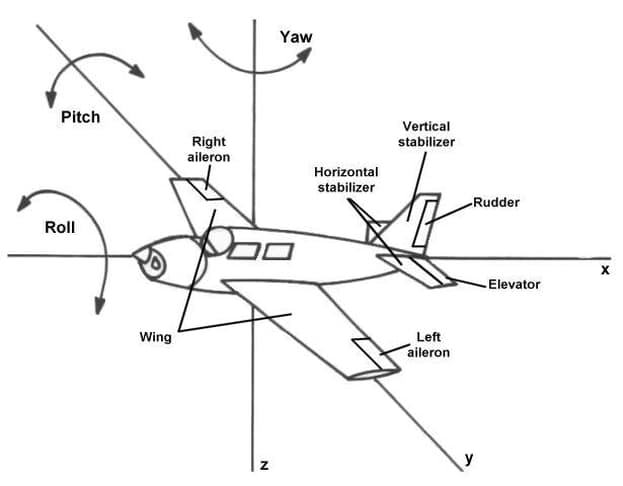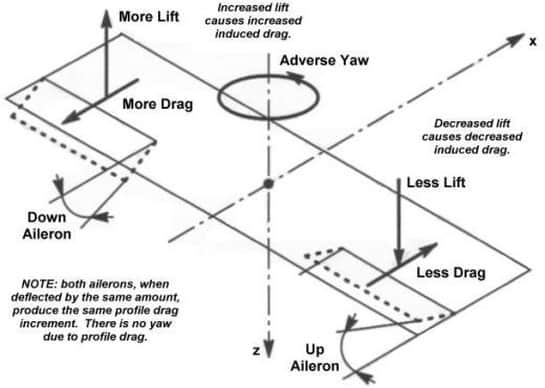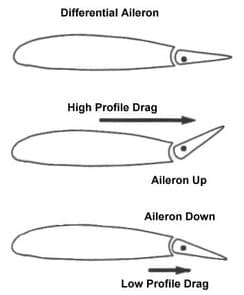# ADVERSE YAW:
Table of Contents:
- What Is Adverse Yaw?
- Pitch, Roll, Yaw
- Methods to Avoid Adverse Yaw
- Frise Ailerons
- Differential Ailerons
- Spoilers
- Cross-Coupled Controls
What Is Adverse Yaw?
- An airplane’s propensity to yaw in the opposite direction of the turn is known as adverse yaw. For instance, your airplane might initially yaw to the left when you roll to the right. In order to comprehend adverse yaw, we must first define an airplane’s axis of motion. As shown below, an aircraft can spin around three distinct axes while it is in flight.

1. Pitch (Adverse Yaw):
- Pitch refers to the up and down rotation of an aircraft’s nose about its y-axis.
- Typically, an elevator on the horizontal tail is used to control the pitch.
2. Roll (Adverse Yaw):
- Roll is the term for the wingtips’ ability to rotate up and down about the x-axis.
- Ailerons at each wingtip are typically used to control roll.
3. Yaw (Adverse Yaw):
- Yaw is the term for the nose’s ability to rotate left and right about the z-axis.
- The rudder on the vertical tail is most frequently used to control yaw.

One control surface’s impact, however, is not usually restricted to just pitch, roll, or yaw. We say that the orientations are connected when the deflection of one control surface affects multiple instances of these orientations. Adverse yaw is the most significant of these related interactions. Let’s look at a graphic of what happens when the pilot deflects the ailerons to roll the airplane to help us better understand the concept.

You can see that the airplane rolls as a result of one aileron being deflected downward and the other upward. When the aileron is deflected downward, the wing’s lift increases because the increased camber is caused by the deflection. On the other hand, since the camber is reduced with the upward deflected aileron, lift on the wing reduces. This variation in lift causes the wing with more lift to roll upward, producing the desired rolling motion.
Moreover, this aileron deflection also has an impact on drag. More specifically, when ailerons are deployed, two forms of drag (induced drag and profile drag) increase. Any surface that produces lift causes induced drag, a type of drag. A surface will produce more induced drag the more lift it produces (for a given wingspan and wing area). As a result, the wing that has the aileron pointed downward to produce more lift also has more induced drag than the other wing.
Profile drag includes all other forms of drag generated by the wing, primarily skin friction and pressure drag. This profile drag increases on both wings when the ailerons are deflected, but the increase is equal when the ailerons are deflected by the same amount. However, the induced drag on each side is not equal, and a larger total drag force exists on the wing with the down aileron. This difference in drag creates a yawing motion in the opposite direction of the roll. Since the yaw motion partially counteracts the desired roll motion, we call this effect adverse yaw.
Methods to Avoid Adverse Yaw:
There are four methods to avoid adverse yaw and are as follows,
- Frise Ailerons
- Differential Ailerons
- Spoilers
- Cross-Coupled Controls
1. Frise Ailerons:
- The idea behind this particular type of aileron is to use the down aileron to reduce wing profile drag while using the up aileron to increase wing profile drag.
- The adverse yaw effect is at least partially cancelled by the difference in profile drag, which counteracts the impact of induced drag.

- Frise ailerons achieve this differential profile drag by keeping the upper surfaces of the wing and aileron smooth, which causes relatively little drag, while the bottom surface of the aileron juts downward, which significantly increases profile drag.
- The performance of frise ailerons is highly reliant on operating conditions, despite the simplicity of this solution and the temporary comfort it offers.
- This is why these ailerons are frequently only partially successful in counteracting unfavourable yaw.
2. Differential Ailerons:
- Deflecting the ailerons in different ways is another way to address adverse yaw.
- The increased profile drag is quite minimal compared to that on the up aileron since the down aileron normally deflects significantly less than the up aileron.

3. Spoilers:
- Spoilers are normally installed over the upper surface of both wings and are long, narrow flat plates. In normal flight, spoilers lie flat and have no impact on the wing’s aerodynamic efficiency.
- The spoilers can, however, be lifted upward into the airflow to produce significant turbulence that lowers lift and raises drag on a wing.

- A spoiler can be used in conjunction with ailerons to decrease lift and increase profile drag on the wing with the up aileron.
- In turn, this causes the wing with the down aileron to experience a significant gain in lift and a relatively moderate increase in drag, compared to the wing with the up aileron, which suffers a significant loss in lift and a substantial rise in drag.
- These factors work together to produce the necessary roll motion as well as a complementary yaw motion known as proverse yaw.
4. Cross-Coupled Controls:
- Ailerons and rudder should be coupled so that both surfaces deflect at the same time as one another. This is one of the most efficient ways to combat adverse yaw.
- The rudder automatically deflects to create a yaw motion in the opposite direction as the ailerons make one in one direction. The unwanted yaw is eliminated as a result of how the two effects interact. A lot of older aircraft’s cable-and-pulley control systems had this type of cross-coupling built in.
- The Wright brothers, who included such controls in the Wright Flyer, were among the first to recognize the issue. A computerized fly-by-wire control system is used by the majority of large aircraft nowadays, and it is easy to program cross-coupled control measures into these automated systems.
To find more topics on our website…
Do you want to refer wikipedia? Please click here…
